Do you wish to know the best push notification software for your blog?
So in this blog, we’ll make a comparison between some of the greatest push notification software in the market.
When you begin with your new blog, your aim is to reach out to more and more people. SEO and email marketing are good ways to do so but many people don’t know that push notifications can also do wonders.
In this article, We will help you discover the best push notification software that can help boost the traffic to your blog.
What is Push Notification Software?
Push notifications are a fantastic feature that lets you stay in contact with people who have left your website. Send customized push notifications to your customers or subscribers for increased traffic, engagement, and conversion.
In addition, you can use push notifications for your application. They can be displayed on the top of a mobile phone or on the lock screen. They are very efficient in keeping users using an application or reconnecting with one they haven’t used for a long time.
This is particularly beneficial because it lets you re-engage clients with reduced procurement costs. Since you could get push notifications while browsing in an application or, at any rate, when your device is locked, this works as a great way to convey messages of urgency from time to time for instance, offers special discounts that last for only a short time period, and so on.
How does push notification software operate?
Push notification technologies enable app developers to interact with consumers in real-time. The download of an app encourages the user to interact with it by sending push notifications to the smartphone. This makes it possible for developers to increase user retention, boost conversions, and build long-lasting relationships with their users. Using push notification software, businesses can stay on the minds of their consumers influence purchases, and build brand loyalty.
What are the benefits of push notification software?
There are several ways through which businesses can benefit from push notification software:
- It may improve consumer engagement and retention by providing real-time, personalized messaging.
- Businesses can use push notification software to track user preferences and behavior for campaigns they design specifically.
- The sales and income may also be increased with respect to sales because it delivers the relevant offers and promotions to the consumers.
- The program can improve the functioning of departments and teams, as well as speed up communication.
- Companies can quickly determine how well their push notifications are performing to improve ROI and adjust their message strategy.
10 Best Push Notification Software in 2025
1. Push engage

PushEngage is the best push notification service provider. Over 10,000+ companies are already using this popular push notification software such as Dominos, Glamour, WPBeginner, Harvard Business Review, and more.
In addition, it’s super easy to use and full of features that will help you reconnect with your readers after they leave your website. For instance, you can have automatic push notifications when you publish new blog posts or send manually crafted messages to your readers.
You can also categorize your readers based on the specific page they visited or their geographic location and send them relevant notifications based on their actions. You can also send triggered notifications based on the actions of your visitors. With the strong goal tracking and analytics tools, you can see how well your push notification campaigns are performing regardless of your business goals.
PushEngage is compatible with all browsers and works on desktops, tablets, and mobile devices like iOS and Android. Other incredible features of PushEngage include A/B testing, automatic drip campaigns, smart opt-in reminders, offline notifications, and much more.
If you’re looking to increase your blog engagement, then you don’t need to look any further than PushEngage.
Key Features:
- Customizable opt-ins
- Full control of the style and design of notifications
- Cart abandonment reminders
- Deep eCommerce integrations
- Personalize notifications with first name, address, and other details
- TurboSend and scheduling to promote time-sensitive offers
- Analytics and A/B testing to help you optimize your campaigns
- GDPR compliant
✅ Pros of PushEngage:
- User Engagement & Retention – Helps bring back visitors with timely push notifications.
- Automation Features – Allows automated campaigns, such as cart abandonment and drip notifications.
- Segmentation & Targeting – Enables user segmentation based on behavior, location, and device.
- A/B Testing – Helps optimize push campaigns by testing different versions.
- Multi-Browser & Multi-Device Support – Works on Chrome, Firefox, Edge, and mobile browsers.
- Advanced Analytics – Provides insights into click rates, conversions, and user behavior.
- No Need for an App – Works directly through browsers without requiring a mobile app.
❌ Cons of PushEngage:
- Limited Free Plan – The free version has restricted features and a limited subscriber count.
- User Opt-In Requirement – Push notifications require users to manually subscribe, limiting reach.
- Can Be Distracting – Excessive notifications may annoy users and lead to unsubscriptions.
- No Email or SMS Support – Focuses only on push notifications, unlike some multi-channel platforms.
- Browser Restrictions – Some browsers, like Safari, may have limited push notification support.
- Pricing Can Get Expensive – Costs can rise as the number of subscribers increases.
Pricing:
- PushEngage costs $9/month, which gives you 1,000 subscribers and limitless notifications.
- Likewise, there’s a restricted free plan, which surrenders you to 500 subscribers and 30 campaigns/month.
2. Onesignal
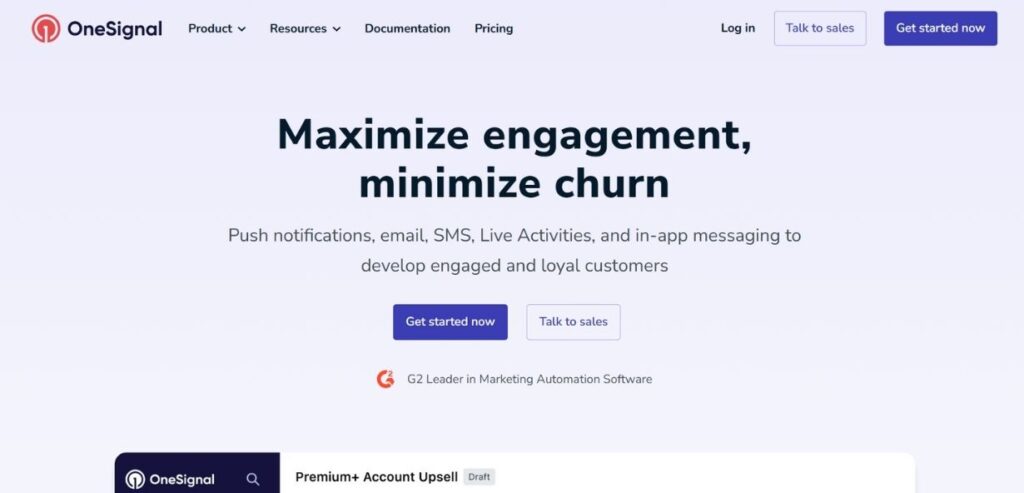
The other popular web push notification plugin is OneSignal. This service sends a notification via email, SMS, and in-app channels, in addition to sending it via web push notifications.
With OneSignal, you have the option to set a delay for your pushes so that they are shown to users after they view a certain number of pages or spend a certain amount of time on your website. This is a great way to increase your subscribers because you’re not bombarding visitors with an opt-in right away.
Like PushEngage, you can do A/B testing, send custom notifications, segment users, view analytics, and much more. The only downside is that OneSignal gets pricier the more features you need, and in comparison to PushEngage, doesn’t offer too many automation or personalization features.
Key Features:
- Integrations with various platforms
- Visual notifications and contextual targeting
- Supports for both web browsers and mobile devices
- Facilitated A/B testing
- Campaign segmentation
✅ Pros of OneSignal:
- Multi-Channel Messaging – Supports push notifications, email, SMS, and in-app messaging.
- Easy Integration – Simple setup with plugins for WordPress, Shopify, and more.
- Advanced Segmentation – Allows precise targeting based on user behavior and preferences.
- Real-Time Analytics – Provides insights into campaign performance instantly.
- A/B Testing – Helps optimize message effectiveness.
- Reliable & Scalable – Handles millions of notifications without delays.
- Free Plan Available – Generous free tier with essential features.
❌ Cons of OneSignal:
- Limited Free Plan – Advanced features require a paid plan.
- Privacy Concerns – Collects user data, which may raise GDPR and compliance issues.
- Learning Curve – Advanced features require some technical knowledge.
- Email & SMS Not as Strong – More focused on push notifications than full email/SMS automation.
- Browser Limitations – Safari and iOS have restrictions on push notifications.
Pricing:
- OneSignal’s Growth plan begins at $12 each month for 1,000 subscribers, giving you their standard personalization and key features.
- Their expert plan begins at $114 each month for 5,000 subscribers and incorporates additional advanced functionality.
3. iZooto
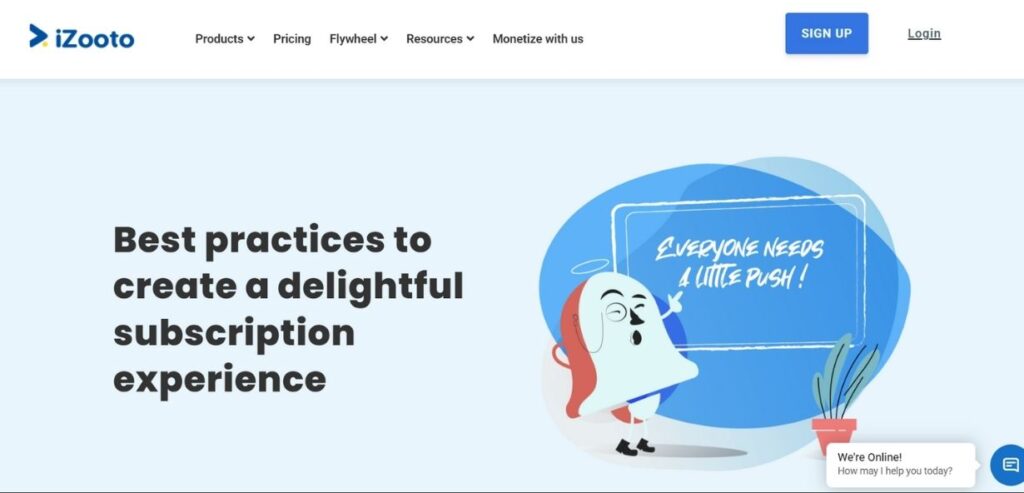
Another tool for web push notifications, in addition to app push and Facebook Messenger, is iZooto.
With the iZooto notification system, you can schedule your opt-in prompt to display when a user has scrolled past a certain point on a page, after a certain amount of time on the page, or when users click on a button.
You can send real-time web push notifications, recurring ones, and scheduled ones once they have opted into your list. It also contains customizable notifications so you can include emojis, icons, images, and call-to-action buttons for even more catchy appearances.
The app also offers very powerful segmentation features that enable capturing specific attributes and behaviors about the users, like their language preference, country, age group, which pages they visited, which blog posts they read, and much more.
iZooto also provides analytics that can be used to gain better insight into your campaigns and learn how to improve them.
Key Features:
- Contextual targeting and geotargeting
- Visual notifications
- Campaign segmentation
- Notification Scheduling
- Reporting and Analytics
✅ Pros of iZooto:
- Owned Audience – Focuses on building direct user engagement without relying on third-party platforms.
- Monetization Option – Allows publishers to earn through push notification ads.
- Multi-Channel Engagement – Supports push notifications, WhatsApp, and Messenger.
- Segmentation & Personalization – Enables precise targeting based on user behavior.
- Automation Features – Includes drip campaigns and scheduled notifications.
- No Need for an App – Works directly through web browsers.
❌ Cons of iZooto:
- Limited Free Plan – Most advanced features require a paid plan.
- Not Ideal for E-Commerce – More suitable for publishers and media websites than online stores.
- Push Notification Fatigue – Excessive notifications may lead to user opt-outs.
- Browser Restrictions – Limited support on iOS/Safari for web push notifications.
- Pricing Can Be Expensive – Costs increase with more subscribers and advanced features.
Pricing:
- iZooto costs from $85/month, which limits you to 30,000 subscribers and unlimited push notifications. There’s no free arrangement accessible. In any case, you can require a 14-day free preliminary (no Visa required).
4. VWO engage
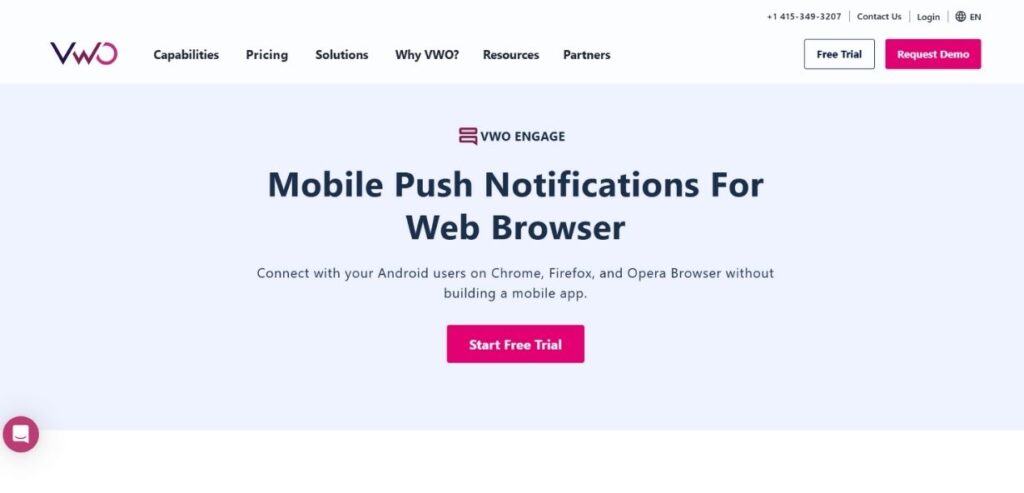
VWO Engage, which was formerly PushCrew, is a mobile and desktop-compatible web push notification software.
Similar to other web and mobile push notifications software solutions in our list, it provides features such as A/B testing, audience segmentation, personalized notifications, and analytics. It further lets you send notifications based on how your readers are interacting with your blog.
You can demonstrate a campaign based on some action, like when a user clicks on a link or scrolls down to some part of the page.
You can create great-looking push notifications without being a designer; you can easily add large images and emojis to them and have your own calls-to-action buttons.
Key Features:
- Suitable for both desktop and mobile
- Easy to use and navigate
- Campaign segmentation
- A/B testing
- Reporting and Analytics
✅ Pros of VWO Engage:
- Multi-Channel Support – Offers web push, mobile push, Facebook Messenger, and SMS.
- Personalization & Segmentation – Allows targeting based on user behavior and attributes.
- Automation & Drip Campaigns – Helps send triggered notifications based on user actions.
- A/B Testing – Optimizes push campaigns for better engagement.
- Easy Integration – Supports WordPress, Shopify, and other platforms.
- Real-Time Analytics – Provides detailed performance insights.
- No Mobile App Required – Works directly through web browsers.
❌ Cons of VWO Engage:
- Limited Free Plan – Paid plans are required for advanced features.
- Browser Limitations – Safari/iOS have restrictions on web push notifications.
- Can Be Distracting – Overuse of notifications may lead to unsubscriptions.
- Not Focused on E-Commerce – More suited for content publishers and SaaS businesses.
- Pricing Can Get Expensive – Costs increase with subscriber growth.
Pricing:
- VWO Engage costs from $99/month. This surrenders you to 10,000 subscribers and unlimited warnings.
- There’s no free arrangement accessible. Nonetheless, you can take a free trial for 30 days, with no Mastercard required.
5. PushAssist
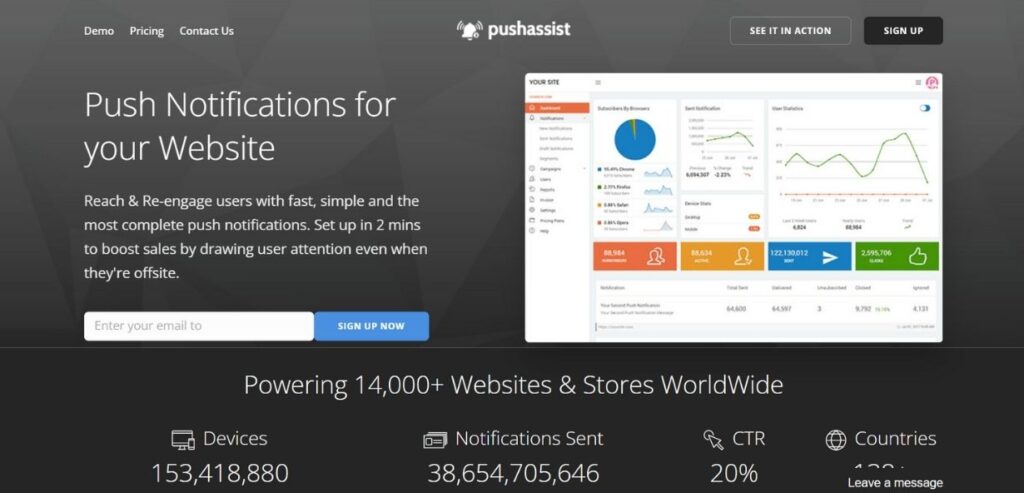
Over 14,000 websites and stores worldwide employ PushAssist, another push notification tool, in support of three popular browsers, namely Chrome, Firefox, and Safari, sending real-time notifications to both desktop and mobile devices.
PushAssist also features audience segmentation, personalization, scheduling, analytics, and more. Among other cool features, there is one that can be used to monetize your push traffic in that you let your readers receive push notifications from advertisers.
Though this may be a great opportunity to make a lot of money online, your credibility and followers might be put at risk by the advertisers and their irrelevant as well as overly invasive ads if you let that happen. It is, however, worth it only if you go for this option, keeping very close tabs on the kind of ads shown to your readers.
Key Features:
- Easy to set up without any hassle
- Support for popular web browsers
- Multi-channel messaging to engage users on their preferred channel
- Multi-device support as per your campaign goal
- Real-time tracking
✅ Pros of PushAssist:
- Easy to Set Up – Simple integration with WordPress, Shopify, and other platforms.
- Multi-Browser Support – Works on Chrome, Firefox, Edge, and Safari.
- Segmentation & Targeting – Allows personalized push notifications.
- Automation Features – Supports scheduled and triggered notifications.
- Free Plan Available – Offers a free tier for small businesses.
- Supports HTTP & HTTPS Sites – Works even for non-secure (HTTP) websites.
❌ Cons of PushAssist:
- Limited Free Plan – Advanced features and higher subscriber limits require a paid plan.
- Basic Analytics – Lacks in-depth performance tracking compared to competitors.
- No Multi-Channel Support – Focuses only on web push notifications (no email or SMS).
- Not Ideal for Large Businesses – Better suited for small and medium-sized websites.
- iOS/Safari Limitations – Limited push notification support on Apple devices.
Pricing:
- PushAssist costs range from $9/month for a maximum of 3,500 subscribers.
- There’s likewise a free arrangement accessible. It supports up to 3,000 subscribers.
6. Webpushr
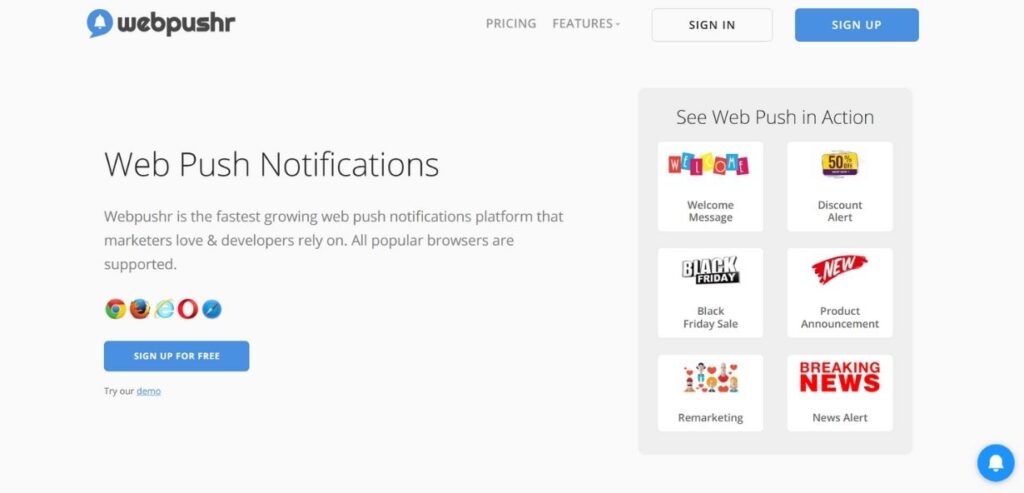
WebPushr is a simple web push notification software that is available for the web and mobile. It supports all the popular browsers like Chrome, Safari, and Firefox.
They offer more than 100 languages and many prompt templates. You can use any of these templates to create a beautiful opt-in prompt. Just change the text and colors and select the behavior when to prompt the users.
This platform also has all features similar to other push notification software. There you can do segmentation, automatic web push notification, scheduling the notification, etc.
It supports your WooCommerce blogs really well: You can use it to inform customers about newly launched products or sales, to send reminders during promotions, and for abandoned cart reminders. Not to mention WebPushr provides easy transfer from previous push notification platform.
Key Features:
- Event-triggered notification
- Support both HTTP and HTTPs sites
- Emoji and large image support
- User segmentation
- Supports all popular browsers
✅ Pros of Webpushr:
- Generous Free Plan – Supports up to 10,000 subscribers with essential features.
- Multi-Browser Support – Works on Chrome, Firefox, Edge, and Safari.
- Easy Integration – Simple setup for WordPress, Shopify, and other CMS platforms.
- Segmentation & Personalization – Allows targeted messaging based on user behavior.
- Automation & Drip Campaigns – Supports scheduled and triggered push notifications.
- Supports HTTP & HTTPS Websites – Works even for non-secure (HTTP) sites.
- Fast Delivery – Ensures instant notification delivery without delays.
❌ Cons of Webpushr:
- Limited Free Plan Features – Advanced automation and analytics require a paid plan.
- No Multi-Channel Support – Only offers web push notifications (no email, SMS, or in-app messaging).
- Basic Analytics – Lacks deep insights compared to competitors like OneSignal.
- Browser Restrictions – Limited support for Safari/iOS push notifications.
- Pricing Can Be Expensive – Costs increase significantly as the subscriber count grows.
Pricing:
- Webpushr costs $29/month for up to 50,000 subscribers and limitless notifications.
- There’s likewise a free plan also accessible, which gives you up to 10,000 subscribers and unlimited notifications.
7. Catapush
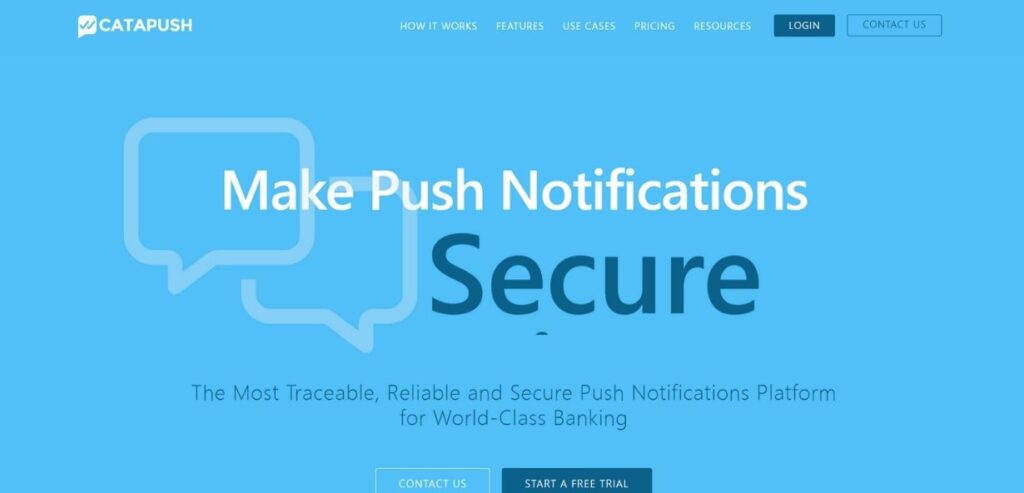
Catapush assures you that your push notifications will reach the customers and you can follow your notifications in real time continuously. For each message that has been sent, conveyed, and read, Catapush will send timestamps for you. There is also end-to-end encryption support so that your customer’s information remains secure.
Data push allows you sufficient personalization of your push notifications. Customers can use SMS backup support too. SMS backup support is to contact your audience offline.
Key Features:
- Text personalization with variable sending
- Leverage customer fallback to reach users offline.
- Single message status tracking
- Two-way communication via API
- Advanced analytics
✅ Pros of Catapush:
- Guaranteed Delivery – Provides real-time tracking of sent, delivered, and read notifications.
- Timestamps for Every Notification – Ensures transparency with detailed logs.
- End-to-End Encryption – Enhances security by protecting user data.
- Data Push for Personalization – Allows businesses to send custom data-rich notifications.
- SMS Backup Support – Sends an SMS if the push notification isn’t delivered, ensuring offline reach.
- Ideal for Critical Notifications – Suitable for industries like finance, healthcare, and logistics.
❌ Cons of Catapush:
- No Multi-Channel Messaging – Focuses only on push notifications and SMS, lacking email or in-app messaging.
- Limited Free Plan – Most advanced features require a paid subscription.
- More Technical Setup – This may require developer support for API integration.
- Not Ideal for Marketing Campaigns – Best for transactional and service-related notifications rather than promotional messaging.
- Pricing Can Be High – The SMS backup feature may increase costs compared to other push notification services.
Pricing:
- A free year basic plan is accessible
- The expert plan is €0.02 (approx. $0,024) per message each month
8. WonderPush
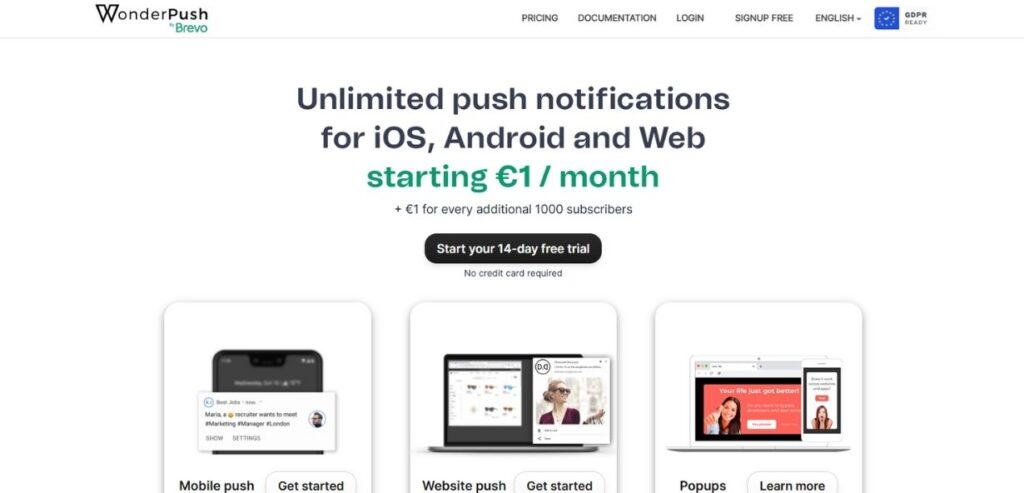
WonderPush is great push notification software for online stores and eCommerce websites. In our testing, we were impressed with all the different kinds of eCommerce notifications you can set up here, including abandoned cart notifications.
It works similar to most other push notification plugins. It allows you to segment your subscribers, automate based on behavior or time, get access to real-time analytics, and more.
You get all the features however much you’re paying. These include unlimited staff members, unlimited notifications, A/B testing, personalization, and more.
Key Features:
- Subscription prompt customization
- Woo-commerce support
- Advanced dashboard
- Real-time analytics
- Woocommerce and AMP support
✅ Pros of WonderPush:
- Affordable Pricing – One of the most cost-effective push notification platforms with a simple pricing model.
- Unlimited Notifications – No limit on the number of push messages sent, even on paid plans.
- Multi-Channel Support – Supports web, mobile (Android/iOS), and in-app push notifications.
- GDPR-Compliant – Fully compliant with data privacy laws, making it a good choice for European businesses.
- Real-Time Analytics – Provides detailed insights into message performance.
- Segmentation & Personalization – Allows precise targeting based on user behavior.
- Fast Integration – Easy setup with WordPress, Shopify, and other platforms.
❌ Cons of WonderPush:
- No Free Plan – Only a 14-day free trial; requires a paid subscription afterward.
- Basic Automation – Lacks advanced automation features like drip campaigns.
- Limited A/B Testing – Doesn’t offer in-depth testing compared to competitors like OneSignal.
- No SMS or Email Support – Focuses only on push notifications, unlike multi-channel platforms.
- iOS/Safari Limitations – Like most push platforms, it has restrictions for Apple devices.
Pricing:
- There is no free plan, but it gives a 14-day free trial without mentioning card details.
- WonderPush has an alternate valuing model from other devices we’ve featured. It costs from €1 each month for up to 1,000 subscribers. After that, it’s an additional €1 for every 1,000 subscribers.
9. Sendpulse
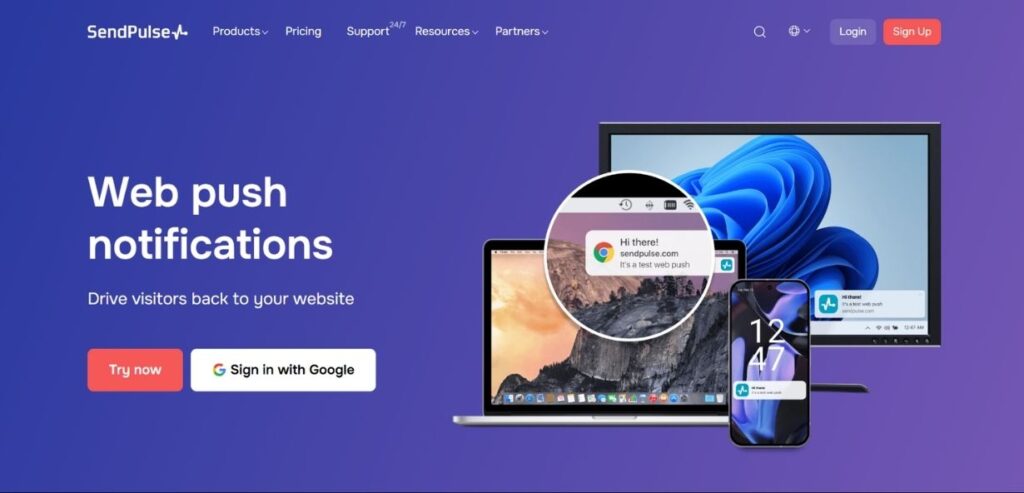
SendPulse excels at converting the average online window shopper into a lifetime customer. It supports all browsers and devices and, being a fully featured marketing platform focuses on growing subscriptions in general, including web push, email, and SMS.
The system of sending notifications can also follow a user behavior pattern. Thus, if a user is searching for a T-shirt, for example, the information about their T-shirt rates will become a custom push message for him. Sendpulse is a good option for marketplaces and online retail chains.
Apart from push notification service, Sendpulse offers a lot of more services, for example, email marketing, Bulk SMS, and SMTP server. It can provide a personalized notification for explicit clients based on usage patterns and location. It upholds programs, for example, Chrome, Firefox, and Safari on desktop and mobile websites.
Key Features:
- Easy to set up
- Offline notifications
- Custom subscription requests
- User personalization and segmentation
- API for developers
✅ Pros of SendPulse:
- Multi-Channel Support – Offers web push, email, SMS, and in-app notifications, providing a unified platform for communication.
- Easy to Use – Intuitive drag-and-drop editor for building campaigns, no coding skills required.
- Automation Features – Includes autoresponders, triggered messages, and email marketing automation.
- Advanced Segmentation – Allows segmentation based on user behavior, demographics, and engagement.
- A/B Testing – Helps optimize push notifications and emails for better performance.
- Free Plan Available – Offers a generous free tier for small businesses (with some limitations).
- Affordable Pricing – Competitive pricing for small to medium-sized businesses.
- Analytics & Reporting – Real-time performance tracking for push, email, and SMS campaigns.
❌ Cons of SendPulse:
- Limited Free Plan – The free plan has limitations on the number of subscribers and features.
- Can Be Overwhelming – With its broad range of features, there may be a learning curve for beginners.
- SMS Delivery Issues – Some users report occasional issues with SMS delivery, particularly in certain countries.
- Limited Customization – The push notification design options are somewhat basic compared to competitors.
- iOS/Safari Push Notification Limitations – Like many push platforms, it has restrictions with iOS devices and the Safari browser.
Pricing:
- Sendpulse web push notifications are free for up to 10000 subscribers and take just a couple of minutes to send.
- For web push service – $19.85/month for 30,000 subscribers and $199.85/month for unlimited subscribers.
10. Aimtell

Aimtell goes a bit further than other push notification services when it comes to very highly personalized push messaging. You can fine-tune your push notifications based on locations, page views, shopping history, wish lists, and a lot of other things. Its forte is re-engagement.
If you do not want your subscribers to view the time-sensitive notifications once they are no longer relevant, allow them an expiration date. Aimtell allows running adverts (and getting paid) by its network of advertisers. It also offers full-service marketing where they can do all the heavy lifting for you if you want them to. With Aimtell, organizations can apply features such as advanced segmenting, custom layouts, automated push warnings, and webhooks.
Similarly, you can apply A/B testing, track your metrics, and set your goals. Additionally, Aimtell offers more features, including lapsing notifications, emoticons, dynamic notifications, and custom branding.
Key Features
- Expiring and dynamic notifications
- Custom templated and automated webhook
- Scheduled notifications and advanced segmenting
- An extensive list of integrations
- Facilitates A/B testing
✅ Pros of Aimtell:
- Advanced Segmentation – Allows detailed targeting based on user behavior, geography, and engagement levels.
- Multi-Channel Support – Supports web push notifications, mobile push, and in-app messages.
- Real-Time Analytics – Provides insights into how your push campaigns are performing.
- Automated Campaigns – Supports triggered push notifications based on specific user actions.
- Personalization – Ability to send tailored push notifications to different user segments.
- Integrations – Easy integration with platforms like WordPress, Shopify, and custom websites via API.
- No Limit on Subscribers – Offers a more flexible model for growing your audience without limits on subscriber count.
❌ Cons of Aimtell:
- No Free Plan – Only a 14-day free trial; paid plans are required after that.
- Pricing Can Be High – Costs can increase significantly as the number of subscribers grows.
- Basic Reporting – While real-time analytics are offered, reporting capabilities could be more advanced compared to competitors like OneSignal.
- Limited SMS Support – Focuses primarily on push notifications, with no built-in SMS or email marketing features.
- Complex Setup – This may require technical knowledge or developer support for advanced features and customizations.
Pricing:
- A free 14-day preliminary is accessible.
- Its basic plan starts from $49 p/m
- Furthermore, plan is $99 p/m
- The Pro plan is $199 p/m
In summary
Push notifications are a very effective way to communicate with the customers. They reach the subscriber’s phone or web browser, which makes them seem to be better than SMS communications and they have a much higher commitment rate. You must start using it now if you haven’t yet to outpace your competitors. Utilize the best push notification software to quickly engage your audience, customize messages, and increase conversions like never before. Do not miss this opportunity!
FAQ
1. What are Push Notifications?
A push notification is a short message that comes on someone’s device, usually coming from an app or website and arriving even when the person is not using it.
2. Is a person able to receive push alerts without an app?
The truth is yes. They will not need to download an app for web push notifications; they can come through the browser.
3. Are push alerts free?
They’re free. While this functionality is the most basic, most of the push notification applications are available free. Special services like large subscriber limitations or automation usually require a fee for such services.
4. How Do I track how well push notifications are doing?
You can view live statistics on the delivery rate, click-through rates, open rates, and so much more since push notification software gets this data based on user interaction.
5. Can you personalize push notifications?
Yes, you can segment your audience with most of the push notification services.

